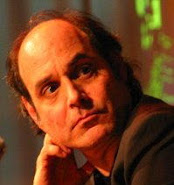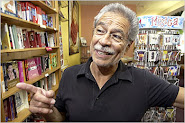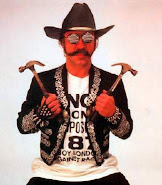
Latino Genius:
Camilo José Vergara

Building photo essays from the ground up:
A lesson plan based on the photography of Camilo José Vergara
Lesson plan by Malena Salazar, M.A., Doctoral Student
Division of Bicultural-Bilingual Studies
The University of Texas – San Antonio
October 2007

Every photograph, besides being a document of what the camera sees,
also testifies to the relationship between the photographer and the subject of the photo.
--Minneapolis Institute of Arts
I use photographs as a means of discovery, as a tool with which to clarify visions and construct knowledge about a particular place, or city.
--Camilo José Vergara

BACKGROUND INFORMATION
Various electronic sources documenting the life and work of Camilo José Vergara:
Wikipedia.com (http://en.wikipedia.org/wiki/Camilo_Jos%C3%A9_Vergara):
Camilo José Vergara (b. 1944) is a Chilean-born, New York-based writer, photographer and documentarian. He was born in Santiago, Chile. Vergara is noted for photographing the same buildings and neighborhoods multiple times over many years to capture changes over time.
Vergara won a MacArthur Foundation "genius grant" in 2002 and served as a fellow at the Mid-Atlantic Regional Center for the Humanities (MARCH) at Rutgers University in 2003/2004. He received the Robert E. Park Award of the American Sociological Association for "The New American Ghetto" in 1997.
In 1995, Vergara made a controversial proposal that 12 square blocks of downtown Detroit be declared a "skyscraper ruins park," an "American acropolis," for the preservation and study of the deteriorating and empty skyscrapers. "We could transform the nearly 100 troubled buildings into a grand national historic park of play and wonder, an urban Monument Valley.... Midwestern prairie would be allowed to invade from the north. Trees, vines, and wildflowers would grow on roofs and out of windows; goats and wild animals—squirrels, possum, bats, owls, ravens, snakes and insects—would live in the empty behemoths, adding their calls, hoots and screeches to the smell of rotten leaves and animal droppings." (Metropolis, April 1995).
Vergara received a B.A. (1968) in sociology from the University of Notre Dame and an M.A. (1977) in sociology from Columbia University, where he also completed the course work for his Ph.D. (not yet awarded). His work has been published in seven books:
1989, Silent Cities: The Evolution of the American Cemetery. ISBN 0910413223
1995, New American Ghetto. ISBN 0813522099
1999, American Ruins. ISBN 1580930565
2001, Twin Towers Remembered. ISBN 1568983514
2001, Unexpected Chicagoland. ISBN 1565847016
2004, Subway Memories. ISBN 1580931464
2005, How the Other Half Worships. ISBN 0813536820
Metrotimes.com (http://www.metrotimes.com/20/19/Features/culRuins.htm):
Ruins & redemption: Maybe celebrating Detroit's crumbling architecture isn't such a crazy idea after all
by Michael Haggerty
2/09/00
It’s not the kind of plan those interested in historic restoration like to hear, but Vergara’s proposal magnified the problem the abandoned buildings present as well as drawing attention to what they represent. While the current dilapidated state of buildings such as the David Broderick Tower and the Michigan Central train depot clearly indicates a decline, the buildings themselves are also symbolic of Detroit’s past achievements.
For that reason, Vergara says even if these buildings aren’t restored, they should not be destroyed. Rather, he suggests that such buildings need to be preserved as symbols of the aspirations they represented when built.
This is particularly true in Detroit, where the concentration of pre-Depression architecture is one of the largest in the country. "Where else do you have these things, and what would you replace them with if you knocked them all down?" he says.
The National Building Museum (http://www.nbm.org/Exhibits/past/2000_1996/Ghetto.html):
The New American Ghetto:Photographs of Camilo José VergaraJanuary 26 - May 5, 1996
The New American Ghetto is an exploration, conducted over nearly two decades, of some of the poorest and most segregated neighborhoods in New York, Newark, Los Angeles, Chicago, Detroit, and other smaller cities. Through photographs and text, I chronicle the profound transformation that these places have experienced since the riots of the 1960s. Included here are successive photographs of the same places that track change over time-the kinds of changes that have made the conditions of today's ghetto profoundly different from those of an earlier era.
My examination of scores of ghettos across the nation reveals three types: green ghettos, characterized by depopulation and by vacant land and ruins over-grown by nature; institutional ghettos, publicly financed places of confinement designed mainly for American-born minorities; and new immigrant ghettos, deriving their character from an influx of immigrants, mainly Latino and West Indian. The New American Ghetto illustrates the ongoing entropy and struggling reconstruction existing in our urban centers today. Some communities have continued to lose population; others have emerged from what were once ethnic, blue-collar neighborhoods; some sections of older ghettos have remained stable, working neighborhoods or have been rebuilt. Cityscapes that were once central to the life and identity of the nation are vanishing, raising fundamental questions: Do we want cities? And how do we interpret what is left behind?

LESSON PLAN
Lesson Plan TitleBuilding photo essays from the ground up: A lesson plan based on the photography of Camilo José Vergara
Overview of Lesson PlanIn this lesson, students will consider the contexts in which photographs are taken and create original photo essays on topics of their choice.
Learning LevelGrades: 6-8, 9-12TEKS
§110.49. Analysis of Visual Media (One-Half Credit).
(b) Knowledge and skills.
(1) The student recognizes/interprets visual representations as they apply to visual media. The student is expected to:
(A) identify the historical development of visual media;
(B) distinguish the purposes of various media forms such as information, entertainment, and persuasion; and
(C) recognize strategies used by media to inform, persuade, entertain, and transmit culture such as advertising, perpetuation of stereotypes, use of visual representations, special effects, and language.
(2) The student analyzes and critiques the significance of visual representations. The student is expected to:
(C) analyze techniques used in visual media;
(D) explore the emotional and intellectual effects of visual media on viewers
Lesson Duration2 sessions, 1 hour
Learning LocationLanguage Arts Classroom or Journalism (with computer access for students)
Learning Objectives
Students will:
1. Analyze photographs to discover their contexts.
2. Consider the influence of photographer Camilo José Vergara on by reading and discussing the website Invincible Cities, http://invinciblecities.camden.rutgers.edu/intro.html
3. Explore Camilo José Vergara’s philosophy about taking pictures of semi-ruined, abandoned buildings; research images on a particular topic in preparation for taking their own pictures on the same topic.
4. Create original photo essays and artist statements.
Resources / Materialsphotographs by Camilo José Vergara (images projected onto a screen); images can be found online at Invincible Cities, http://invinciblecities.camden.rutgers.edu/intro.html
pens/pencils
paper
classroom board
copies of Site Introduction by Camilo Vergara found online at http://invinciblecities.camden.rutgers.edu/intro.html (one per student)
resources that contain photographs that may interest students; found in photography books, periodicals, reference books, computers with Internet access, etc.
digital or disposable cameras (one per student)
computers for students to download and print digital photographs
Activities / ProceduresStep 1. WARM-UP/DO-NOW:Prior to class, prepare a projector to show the series of photographs taken by Camilo José Vergara found in Invincible Cities, http://invinciblecities.camden.rutgers.edu/intro.html .
As students enter the room, ask them to examine the images.
As a class, discuss the following questions for each photograph (written on the board or overhead):
-What are these pictures of?
-What do you think the real-life context is for these pictures?
-Why do you think they were taken?
-What title would you give this series of photographs? Why?
After discussing the series of photographs, read aloud the caption or accompanying text, as well as the title. Then ask students the following questions (written on the board or overhead):-How do the photographs capture the context?-What was happening when the picture was taken?
Step 2. CLASS READ AND DISCUSS SITE INTRODUCTION.Have the class read and discuss copies of SITE INTRODUCTION by Camilo Vergara found online as pdf files at http://invinciblecities.camden.rutgers.edu/Images%20as%20a%20Tool%20of%20Discovery.pdf
focusing on the following questions:
a. Who is Camilo José Vergara?
b. What type of work does he do?
c. Why does he employ the use of still photography?
d. What is he trying to accomplish with his photography? Why?
e. How does Camilo José Vergara chose his subject?
Step 3. CLASS DISCUSSION OF QUOTE.As a class, discuss the following quotation by Camilo José Vergara:
“For me a visual history of urban America organized around portraits of minority residents would be very limited. People are often engaging; their feelings and emotions are moving; yet it is often difficult to know much about them from photographic likenesses. I found that images of the physical communities in which people live often better reveal the choices made by residents and city officials over the long haul. When presented together as a series, photographs of the built environment constitute the essential element of an urban history told from the ground up. I use photographs as a means of discovery, as a tool with which to clarify visions and construct knowledge about a particular place, or city.”
Ask students the following questions:
What does this quotation mean to you?
What topics is he talking about?
List these topics on the board, as well as any other ideas that may be relevant to this quotation. Topics may include the ghetto, poverty, race, politics, pollution, education, urban life, etc.
Pair work:Divide the class into pairs.
Explain that each pair will be creating a photo essay that will include at least five photographs with captions.
What issue, event, location, person, movement, etc. is worth documenting?
What images would help to capture that issue, event, location, person, movement, etc.?
Allow students time to choose a subject from those previously written on the board or come up with their own.
Once student pairs have agreed on their subjects, allow time for them to research existing photographs.
Encourage students to take notes on the kinds of images they find, and to answer the following guiding questions (written on the board or copied into a handout):-How has the issue, event, location, person, movement, etc. been captured to date?-Which images are most effective? Why?-Which images are least effective? Why?-What images would make your subject appear ordinary or clichéd?-Discuss new ways your subject can be photographed, including contexts, locations, angles, etc.
Step 4. WRAP-UP/HOMEWORK:
Student pairs take pictures for their photo essays and develop or print them. They then choose the five images that best illustrate their thoughts as reviewed during the main activity. Student pairs then write captions for each image. Individually, students prepare artist statements expressing what they hope others will learn from their photo essays. Students present photo essays with captions, along with their artist statements, in a future class as part of a photojournalism exhibit.Further Questions for Discussion:-Why do people take pictures?-How are photographs used in your everyday life?-How can the use of photographs enhance the landscape of a city?-Why might an influential photographer/artist not be very well-known?Evaluation / AssessmentStudents will be evaluated based on participation in class and pair discussions, thorough research and analyses of images on their chosen topics, completion of photo essays, and thoughtful artist statements. Refer to Addendums A and B for grading rubrics.
[CLICK HERE FOR ADDENDUM A HYPERLINK AND ADDENDUM B HYPERLINK]
Vocabulary
rehabilitation, abandonment, visual history, fortification, empty lots, visual language of art and advertisement, social containers, public billboards, urbanization, ethnography
Extension Activities
1. Write an essay explaining how a photograph is different from a painting, sculpture, dance, or song.
2. Create an illustrated timeline of Camilo José Vergara’s career and body of works. Include images that have helped to define his work as a photographer and ethnographer.
3. Interview a family member about a mentor he or she has had. Explore the ways this mentor influenced his or her life. Prepare a newspaper article illustrating your findings.
Technology related exploration - Research the photography equipment used by Camilo José Vergara. Choose one, and create a “How It Works” poster. Write a brief essay comparing this piece of equipment to a camera you could use for your photo essay.
References
Camilo José Vergara. (2006, October 24). In Wikipedia, The Free Encyclopedia. Retrieved September 13, 2007, from http://en.wikipedia.org/w/index.php?title=Camilo_Jos%C3%A9_Vergara&oldid=83459666
Haggerty, M. (2000, February 9). Ruins & redemption: Maybe celebrating Detroit's crumbling architecture isn't such a crazy idea after all. Metrotimes. Retrieved September 11, 2007, from http://www.metrotimes.com/20/19/Features/culRuins.htm
Minneapolis Institute of Arts. (n.d.). Get the picture: Liebling. In Retrieved September 22, 2007, from http://www.artsmia.org/get-the-picture/liebling/frame05.html
Sale, M. & Anderson, B. (2006, October 20). The candid camera: Creating photo essays that keep it real. The New York Times Company. Retrieved September 12, 2007, from http://www.nytimes.com/learning/teachers/lessons/20061020friday.html
The National Building Museum. (1996). The new American ghetto: Photographs of Camilo José Vergara (January 26 - May 5, 1996). Retrieved September 14, 2007, from http://www.nbm.org/Exhibits/past/2000_1996/Ghetto.html
Vergara, C. J. & Gillette, H. (2005). Invincible Cities. Retrieved September 12, 2007, from http://invinciblecities.camden.rutgers.edu/intro.html








 Irma Vargas Rosas
Irma Vargas Rosas  Jessica Muniz
Jessica Muniz Lora Beth Escalante
Lora Beth Escalante Lorena Claeys
Lorena Claeys















